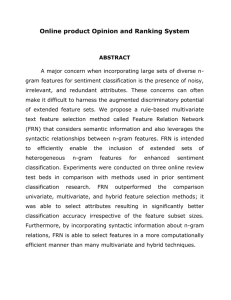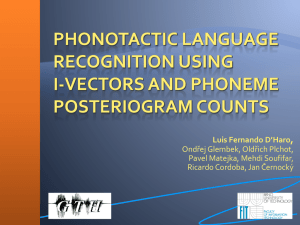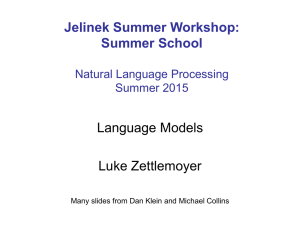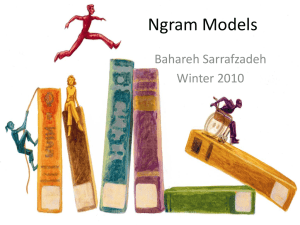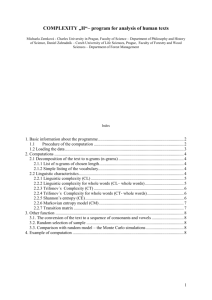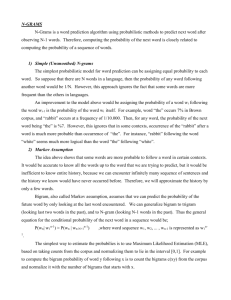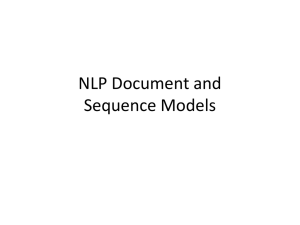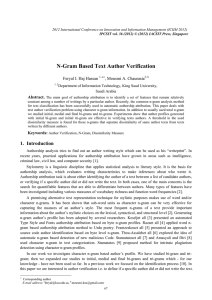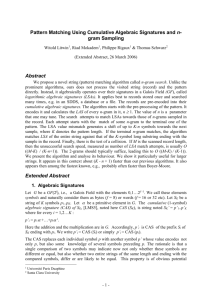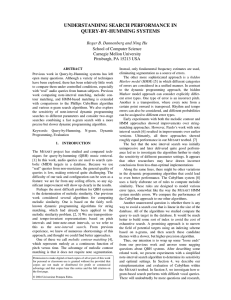Efficient Minimal Perfect Hash Language Models
advertisement
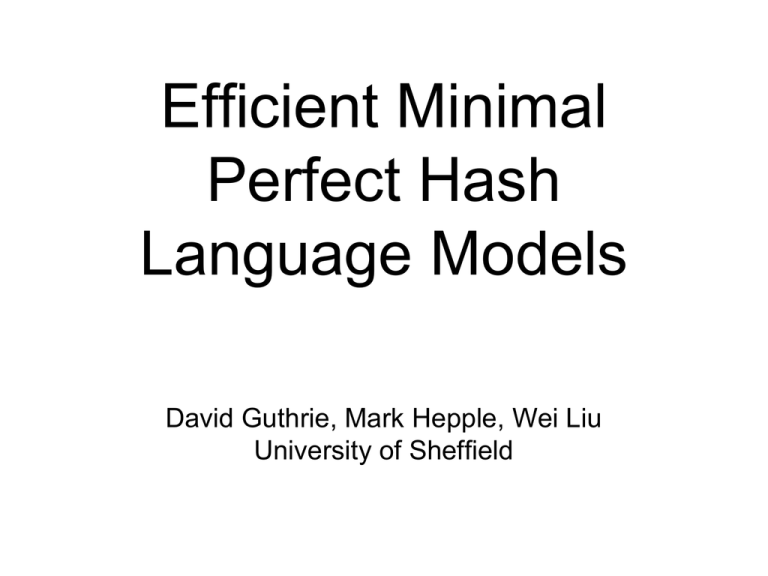
Efficient Minimal Perfect Hash Language Models David Guthrie, Mark Hepple, Wei Liu University of Sheffield Large LMs • Brants et al. (2007) showed that MT quality continues to improve even when training corpus size is increased above 1 trillion tokens • Google Web 1T corpus contains 3.8 Billion unique n-grams and is 25GB compressed • LM toolkits can not store this amount of data in memory Methods for Reducing the size of LMs • Prune vocabulary • Prune low frequency n-grams • Entropy pruning • Quantizing counts or probabilities divide the probability range into Q discrete values. Each n-gram probability is therefore ‘rounded’ to one of the Q values and requires only log2 Q bits to store • Models are still too large to store using LM toolkits Trie Data Structure • • Most language modeling toolkits including SRILM toolkit, CMU toolkit, and IRSTLM use variations of the trie structure Compact tree structure where each node stores the unique prefixes of the nodes below it in the tree Trie Data Structure • n-1 binary searches to locate an n-gram O(log2 N) • Allows enumerations of n-grams starting with different word sequences • Most compact representation uses 7.2 Bytes per n-gram to store a trigram LM using 8 bit quantized counts (with 32 bit word vocabulary) • • • • Random Access Language Models Work by Talbot and Brants (2008) make use of bloomier filters to map n-grams to their associated probabilities or counts Store language models without storing the actual n-gram key in the structure and allowing a small probability of returning a false positive Save significant space but do not allow enumeration over n-grams Uses in 3.08 Bytes per n-gram to store 8-bit quantized probabilities Introducing MPHR • We developed two new structures called Single Minimal Perfect Hash Ranking and Tiered Minimal Perfect Hash Ranking • Use significantly less space than all known approaches • allowing full n-gram frequency counts to be stored in up to 36% of the space of Random Access Bloomier Filter • O(1) random access and O(n) construction Single MPHR Structure • Stage 1: Minimal Perfect Hash Function • Stage 2: Fingerprint Rank Array • Stage 3: Unique Value Array Perfect Hashing (a) Perfect Hash (b) Minimal Perfect Hash • • • Storing n-grams We use a minimal perfect hash function to map every n-gram in the training data to a distinct integer in the range 0 to N − 1, where N is the total number of n-grams to store Function is perfect, so it is guaranteed to return unique integers for every seen ngram We can use these integers a indices to an array and store values at that location False Positives • • Querying an n-gram from training always returns the correct index into the array But the hash function will also return integer values in the range 0 to N − 1 for n-grams that have not been seen before (i.e. were not used to build the hash function)! Storing Fingerprints Storing Values Values • • • For every n-gram, we store the ‘rank’ of the frequency count and use a separate array in Stage 3 to store the actual value motivated by the distribution of n-gram frequency counts in corpora If there are R distinct ranks then we only need to store ⌈log2 R⌉ bits rather than bits required to store the largest frequency count Unique Frequencies Single MPHR structure Comparison of Space Usage Bloomier Storing 8 bit quantized values and using 12 bit fingerprints Storing Full Counts • Store full frequency counts for all 3.8 billion ngrams in the Google Web 1T corpus • Bloomier Filter requires: 7.53 bytes/ngram or 26.63GB • Single MPHR requires: 4.26 bytes/ngram or 15.05GB • Single MPHR uses 53% of the space required by Bloomier if we apply the same rank array optimization to Bloomier approach MPHR still uses 86% of the Tiered MPHR • In Google Web 1T data the first 256 ranks account for 85% of the n-grams • Use single top level used MPHR to store all fingerprints and some space for rank values and some for redirection to secondary hashes • Secondary MPH functions are computed only for the keys they store and no need to store fingerprints Tiered MPHR Tiered MPHR for Google 1T Data Storing full frequency count information for all 1 to 5 grams with 12 bit fingerprints Summary • We developed an efficient methods of storing large language models • Allows for probability values or counts to be stored and accessed in constant time. Approximately 1000 times faster than using a modern database • Uses significantly less space than all known approaches. Allows for storage of full frequency count information using less than 3 Bytes per n-gram
